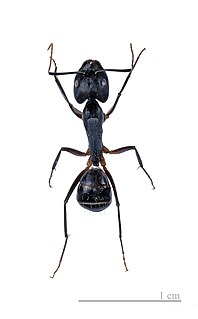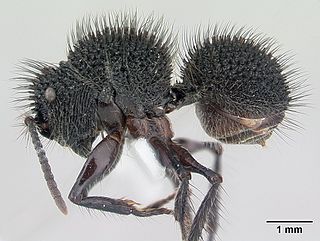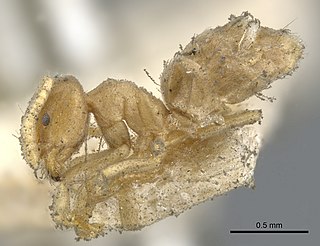
Myrmecology is a branch of entomology focusing on the scientific study of ants. Some early myrmecologists considered ant society as the ideal form of society and sought to find solutions to human problems by studying them. Ants continue to be a model of choice for the study of questions on the evolution of social systems because of their complex and varied forms of eusociality. Their diversity and prominence in ecosystems also has made them important components in the study of biodiversity and conservation. Recently, ant colonies are also studied and modeled for their relevance in machine learning, complex interactive networks, stochasticity of encounter and interaction networks, parallel computing, and other computing fields.

The Formicinae are a subfamily within the Formicidae containing ants of moderate evolutionary development.

Dolichoderinae is a subfamily of ants, which includes species such as the Argentine ant, the erratic ant, the odorous house ant, and the cone ant. The subfamily presents a great diversity of species throughout the world, distributed in different biogeographic regions, from the Palearctic, Nearctic, Afrotropical region and Malaysia, to the Middle East, Australian, and Neotropical regions.

Anonychomyrma is a genus of ants in the subfamily Dolichoderinae.

Aphaenogaster is a genus of myrmicine ants. About 200 species have been described, including 18 fossil species. They occur worldwide except in South America south of Colombia, Sub-Saharan Africa, and Antarctica.

Crematogaster is an ecologically diverse genus of ants found worldwide, which are characterised by a distinctive heart-shaped gaster (abdomen), which gives them one of their common names, the Saint Valentine ant. Members of this genus are also known as cocktail ants because of their habit of raising their abdomens when alarmed. Most species are arboreal. These ants are sometimes known as acrobat ants.

Basiceros is a genus of ants in the subfamily Myrmicinae.

Podomyrma is a genus of ants in the subfamily Myrmicinae.

Vollenhovia is a genus of ants in the subfamily Myrmicinae.

Carebara is a genus of ants in the subfamily Myrmicinae. It is one of the largest myrmicine genera with more than 174 species distributed worldwide in the tropics and the Afrotropical region. Many of them are very tiny cryptic soil and leaf litter inhabitants. They nest in rotten wood to which the bark is still adherent in the Afrotropical region, or may be lestobiotic nesting near other ant species. Some species are known to exist parasitically within termite nests. Little is known about the biology of the species. However, they are notable for the vast difference in size between queens and workers.

Echinopla is a genus of ants in the subfamily Formicinae. The genus is distributed from Singapore and Sumatra (Indonesia) to the Philippines, Papua New Guinea and Australia.

Pseudolasius is a genus of ants in the subfamily Formicinae. The genus is known from southern Asia to northern Australia, where it appears to be restricted to tropical areas.
Chronoxenus butteli is an Indonesian ant of the genus Chronoxenus. It was once considered to be a part of the genus Iridomyrmex, and was moved from there to Chronoxenus. It was described by Forel in 1913.

Bothriomyrmecini is a tribe of Dolichoderinae ants with 5 genera.

Chronoxenus myops is a species of ant of the genus Chronoxenus. It was described by Forel in 1895.
Chronoxenus walshi is a species of ant of the genus Chronoxenus. It was described by Forel in 1895, and was formerly a part of the genus Iridomyrmex. They are endemic to Bangladesh, India and China.
Chronoxenus dalyi is a species of ant of the genus Chronoxenus. It was described by Forel in 1895. The ant is endemic to Bangladesh, India, Nepal and China.
Chronoxenus wroughtonii is a species of ant of the genus Chronoxenus. It was described by Forel in 1895, and was once apart of the genus Iridomyrmex. They are endemic to China, India and South Korea.














